Networked Application Management: Blockchain Analysis Report
VerifiedAdded on 2021/06/14
|9
|2654
|79
Report
AI Summary
This report provides a comprehensive overview of blockchain technology, examining its architecture, features, and associated challenges. It delves into the application of blockchain in various domains, with a specific focus on Bitcoin as a cryptocurrency and its role in the Internet of Things (IoT), particularly in the context of cooperatively owned self-driving cars. The report also analyzes the socio-technical aspects of these applications, including the impact on transactions, security, machine learning, and ease of use. It concludes by emphasizing the importance of blockchain as a distributed ledger for secure and cost-effective data transactions, highlighting its potential to revolutionize networked applications. The report further mentions the benefits of Bitcoin's asymmetric encryption and the mining process, while also outlining the impact of machine learning on self-driving cars and its ease of use.
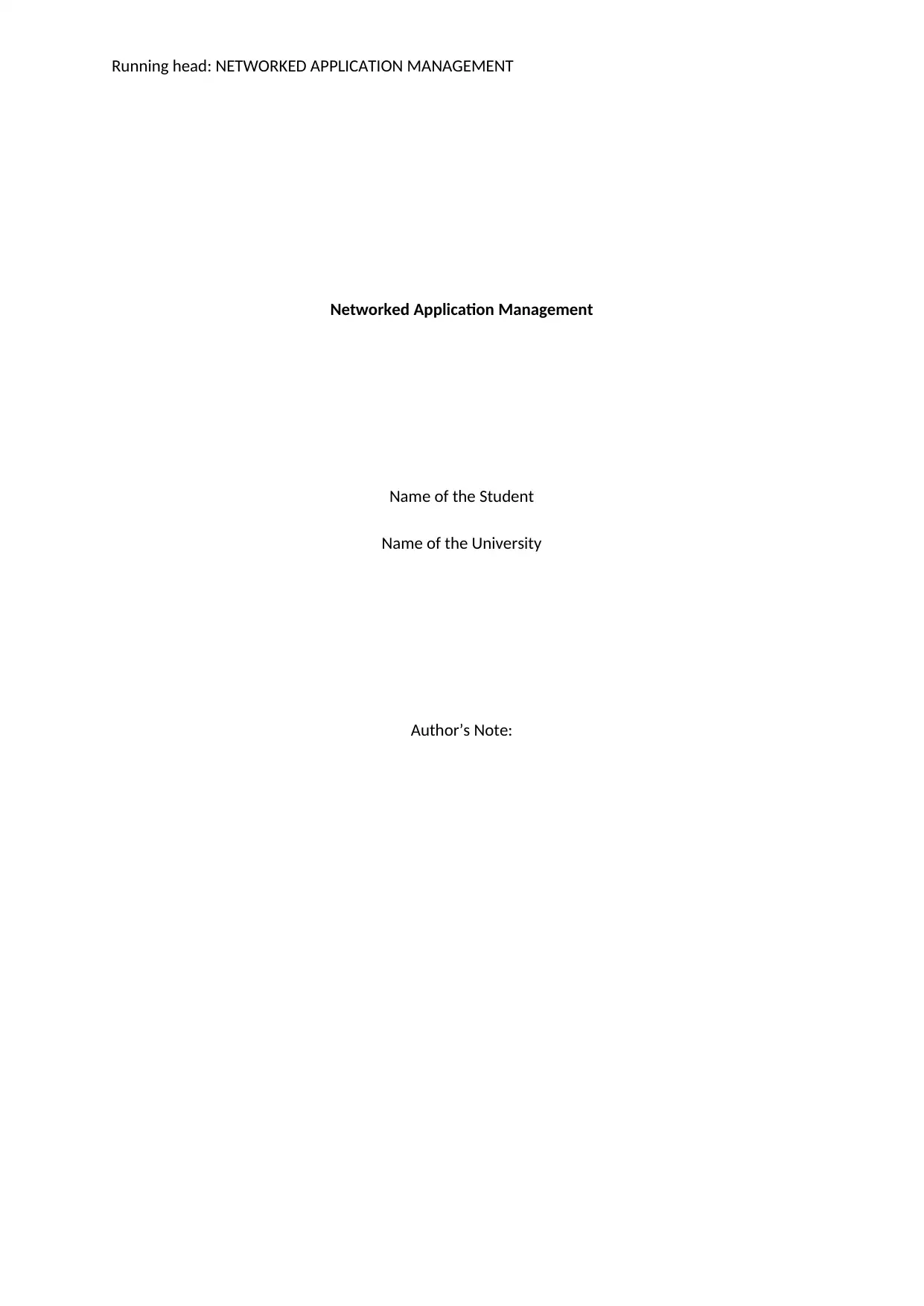
Running head: NETWORKED APPLICATION MANAGEMENT
Networked Application Management
Name of the Student
Name of the University
Author’s Note:
Networked Application Management
Name of the Student
Name of the University
Author’s Note:
Paraphrase This Document
Need a fresh take? Get an instant paraphrase of this document with our AI Paraphraser

1
NETWORKED APPLICATION MANAGEMENT
Table of Contents
Introduction...........................................................................................................................................2
Discussion..............................................................................................................................................2
Part 1: Blockchain..............................................................................................................................2
Part 2: Applications of Blockchain.....................................................................................................4
Part 3: Socio-Technical Aspects.........................................................................................................5
Conclusion.............................................................................................................................................6
References.............................................................................................................................................7
NETWORKED APPLICATION MANAGEMENT
Table of Contents
Introduction...........................................................................................................................................2
Discussion..............................................................................................................................................2
Part 1: Blockchain..............................................................................................................................2
Part 2: Applications of Blockchain.....................................................................................................4
Part 3: Socio-Technical Aspects.........................................................................................................5
Conclusion.............................................................................................................................................6
References.............................................................................................................................................7
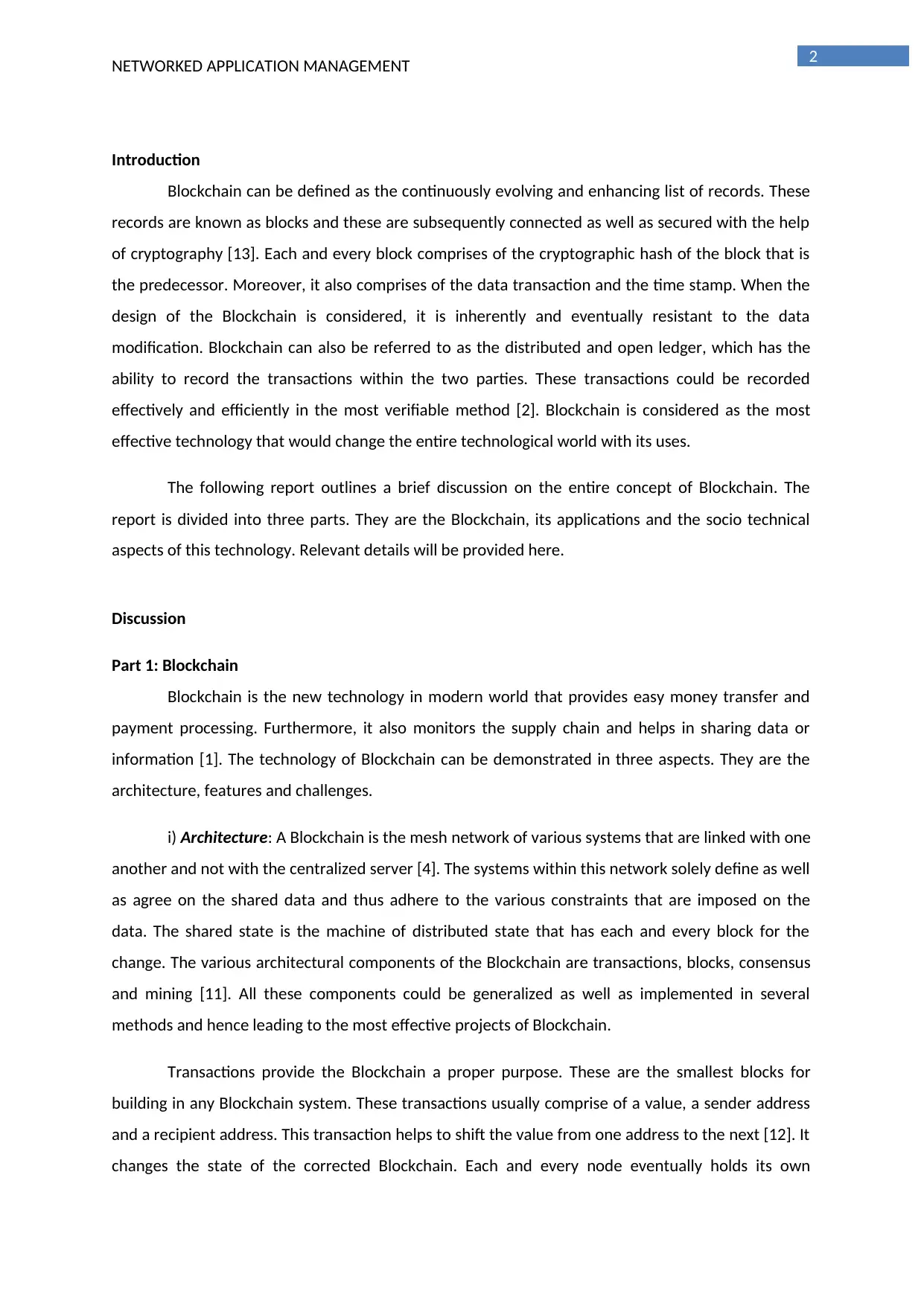
2
NETWORKED APPLICATION MANAGEMENT
Introduction
Blockchain can be defined as the continuously evolving and enhancing list of records. These
records are known as blocks and these are subsequently connected as well as secured with the help
of cryptography [13]. Each and every block comprises of the cryptographic hash of the block that is
the predecessor. Moreover, it also comprises of the data transaction and the time stamp. When the
design of the Blockchain is considered, it is inherently and eventually resistant to the data
modification. Blockchain can also be referred to as the distributed and open ledger, which has the
ability to record the transactions within the two parties. These transactions could be recorded
effectively and efficiently in the most verifiable method [2]. Blockchain is considered as the most
effective technology that would change the entire technological world with its uses.
The following report outlines a brief discussion on the entire concept of Blockchain. The
report is divided into three parts. They are the Blockchain, its applications and the socio technical
aspects of this technology. Relevant details will be provided here.
Discussion
Part 1: Blockchain
Blockchain is the new technology in modern world that provides easy money transfer and
payment processing. Furthermore, it also monitors the supply chain and helps in sharing data or
information [1]. The technology of Blockchain can be demonstrated in three aspects. They are the
architecture, features and challenges.
i) Architecture: A Blockchain is the mesh network of various systems that are linked with one
another and not with the centralized server [4]. The systems within this network solely define as well
as agree on the shared data and thus adhere to the various constraints that are imposed on the
data. The shared state is the machine of distributed state that has each and every block for the
change. The various architectural components of the Blockchain are transactions, blocks, consensus
and mining [11]. All these components could be generalized as well as implemented in several
methods and hence leading to the most effective projects of Blockchain.
Transactions provide the Blockchain a proper purpose. These are the smallest blocks for
building in any Blockchain system. These transactions usually comprise of a value, a sender address
and a recipient address. This transaction helps to shift the value from one address to the next [12]. It
changes the state of the corrected Blockchain. Each and every node eventually holds its own
NETWORKED APPLICATION MANAGEMENT
Introduction
Blockchain can be defined as the continuously evolving and enhancing list of records. These
records are known as blocks and these are subsequently connected as well as secured with the help
of cryptography [13]. Each and every block comprises of the cryptographic hash of the block that is
the predecessor. Moreover, it also comprises of the data transaction and the time stamp. When the
design of the Blockchain is considered, it is inherently and eventually resistant to the data
modification. Blockchain can also be referred to as the distributed and open ledger, which has the
ability to record the transactions within the two parties. These transactions could be recorded
effectively and efficiently in the most verifiable method [2]. Blockchain is considered as the most
effective technology that would change the entire technological world with its uses.
The following report outlines a brief discussion on the entire concept of Blockchain. The
report is divided into three parts. They are the Blockchain, its applications and the socio technical
aspects of this technology. Relevant details will be provided here.
Discussion
Part 1: Blockchain
Blockchain is the new technology in modern world that provides easy money transfer and
payment processing. Furthermore, it also monitors the supply chain and helps in sharing data or
information [1]. The technology of Blockchain can be demonstrated in three aspects. They are the
architecture, features and challenges.
i) Architecture: A Blockchain is the mesh network of various systems that are linked with one
another and not with the centralized server [4]. The systems within this network solely define as well
as agree on the shared data and thus adhere to the various constraints that are imposed on the
data. The shared state is the machine of distributed state that has each and every block for the
change. The various architectural components of the Blockchain are transactions, blocks, consensus
and mining [11]. All these components could be generalized as well as implemented in several
methods and hence leading to the most effective projects of Blockchain.
Transactions provide the Blockchain a proper purpose. These are the smallest blocks for
building in any Blockchain system. These transactions usually comprise of a value, a sender address
and a recipient address. This transaction helps to shift the value from one address to the next [12]. It
changes the state of the corrected Blockchain. Each and every node eventually holds its own
⊘ This is a preview!⊘
Do you want full access?
Subscribe today to unlock all pages.

Trusted by 1+ million students worldwide
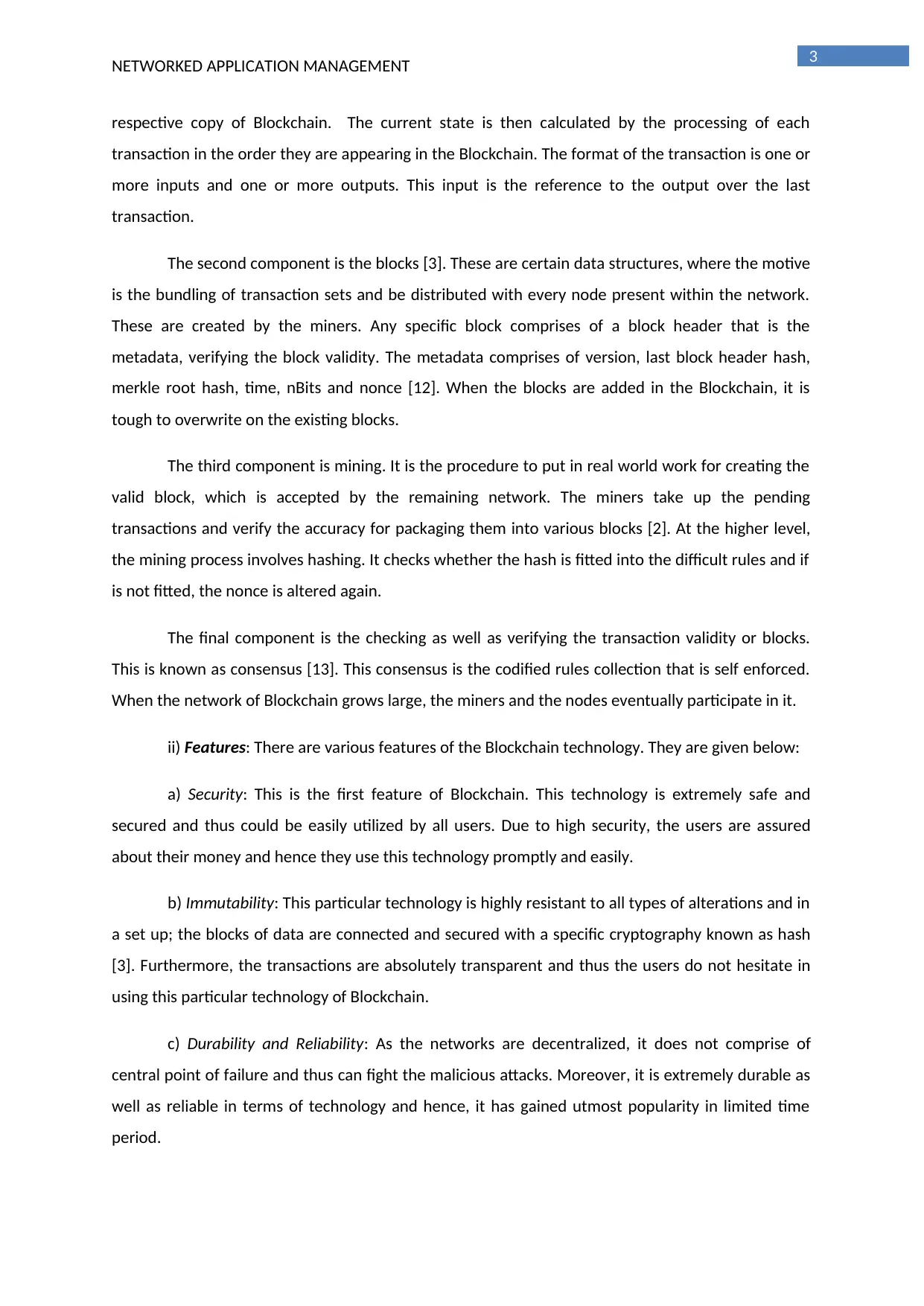
3
NETWORKED APPLICATION MANAGEMENT
respective copy of Blockchain. The current state is then calculated by the processing of each
transaction in the order they are appearing in the Blockchain. The format of the transaction is one or
more inputs and one or more outputs. This input is the reference to the output over the last
transaction.
The second component is the blocks [3]. These are certain data structures, where the motive
is the bundling of transaction sets and be distributed with every node present within the network.
These are created by the miners. Any specific block comprises of a block header that is the
metadata, verifying the block validity. The metadata comprises of version, last block header hash,
merkle root hash, time, nBits and nonce [12]. When the blocks are added in the Blockchain, it is
tough to overwrite on the existing blocks.
The third component is mining. It is the procedure to put in real world work for creating the
valid block, which is accepted by the remaining network. The miners take up the pending
transactions and verify the accuracy for packaging them into various blocks [2]. At the higher level,
the mining process involves hashing. It checks whether the hash is fitted into the difficult rules and if
is not fitted, the nonce is altered again.
The final component is the checking as well as verifying the transaction validity or blocks.
This is known as consensus [13]. This consensus is the codified rules collection that is self enforced.
When the network of Blockchain grows large, the miners and the nodes eventually participate in it.
ii) Features: There are various features of the Blockchain technology. They are given below:
a) Security: This is the first feature of Blockchain. This technology is extremely safe and
secured and thus could be easily utilized by all users. Due to high security, the users are assured
about their money and hence they use this technology promptly and easily.
b) Immutability: This particular technology is highly resistant to all types of alterations and in
a set up; the blocks of data are connected and secured with a specific cryptography known as hash
[3]. Furthermore, the transactions are absolutely transparent and thus the users do not hesitate in
using this particular technology of Blockchain.
c) Durability and Reliability: As the networks are decentralized, it does not comprise of
central point of failure and thus can fight the malicious attacks. Moreover, it is extremely durable as
well as reliable in terms of technology and hence, it has gained utmost popularity in limited time
period.
NETWORKED APPLICATION MANAGEMENT
respective copy of Blockchain. The current state is then calculated by the processing of each
transaction in the order they are appearing in the Blockchain. The format of the transaction is one or
more inputs and one or more outputs. This input is the reference to the output over the last
transaction.
The second component is the blocks [3]. These are certain data structures, where the motive
is the bundling of transaction sets and be distributed with every node present within the network.
These are created by the miners. Any specific block comprises of a block header that is the
metadata, verifying the block validity. The metadata comprises of version, last block header hash,
merkle root hash, time, nBits and nonce [12]. When the blocks are added in the Blockchain, it is
tough to overwrite on the existing blocks.
The third component is mining. It is the procedure to put in real world work for creating the
valid block, which is accepted by the remaining network. The miners take up the pending
transactions and verify the accuracy for packaging them into various blocks [2]. At the higher level,
the mining process involves hashing. It checks whether the hash is fitted into the difficult rules and if
is not fitted, the nonce is altered again.
The final component is the checking as well as verifying the transaction validity or blocks.
This is known as consensus [13]. This consensus is the codified rules collection that is self enforced.
When the network of Blockchain grows large, the miners and the nodes eventually participate in it.
ii) Features: There are various features of the Blockchain technology. They are given below:
a) Security: This is the first feature of Blockchain. This technology is extremely safe and
secured and thus could be easily utilized by all users. Due to high security, the users are assured
about their money and hence they use this technology promptly and easily.
b) Immutability: This particular technology is highly resistant to all types of alterations and in
a set up; the blocks of data are connected and secured with a specific cryptography known as hash
[3]. Furthermore, the transactions are absolutely transparent and thus the users do not hesitate in
using this particular technology of Blockchain.
c) Durability and Reliability: As the networks are decentralized, it does not comprise of
central point of failure and thus can fight the malicious attacks. Moreover, it is extremely durable as
well as reliable in terms of technology and hence, it has gained utmost popularity in limited time
period.
Paraphrase This Document
Need a fresh take? Get an instant paraphrase of this document with our AI Paraphraser

4
NETWORKED APPLICATION MANAGEMENT
d) Integrity: The users can easily trust the technology as the data is not changed in this
purpose [14]. Since, the users are assured about the data integrity, they always utilize this particular
technology for the purpose of money transactions.
iii) Challenges: In spite of having various advantages and features, this particular technology
do comprises of few challenges within it. The most significant challenges of the Blockchain
technology are as follows:
a) Initial Costs: With the implementation of Blockchain technology, the long term advantages
in respect to the efficiency and productivity is enhanced [2]. However, the main problem of this
particular technology is that the initial costs are extremely high and thus everybody cannot easily
afford them. Apart from the software cost, the personnel cost is also high here.
b) Integration with Legacy Systems: A specific integration with the legacy systems is
mandatory for the Blockchain technology and thus various users cannot take up this technology.
Moreover, it incurs huge cost and time [1].
c) Higher Energy Consumption: The third challenge with Blockchain technology is that is
consumes extremely high energy and thus it becomes often a problem for the users to incorporate
this technology.
Part 2: Applications of Blockchain
The applications of Blockchain are present in every domain. Following are the two domains
with relevant applications.
i) Currency: For the domain of currency, the most popular and suitable application of
Blockchain is Bitcoin [6]. It is typical kind of crypto currency as well as payment system that is being
utilized worldwide. It is the very first decentralized currency that is digital, since all the systems work
without the help of any administrator or centralized banks. The network here is peer to peer or P2P
and thus the transactions that take place are directly between the users and without the presence of
any intermediary. All the transactions are properly verified with the help of network nodes, with the
utilization of cryptography [5]. They are recorded in the publicly distributed ledger, known as
Blockchain.
This particular currency was invented by an anonymous individual or group, with the name
of Satoshi Nakamoto. Bitcoin was first released as the open source software in the year 2009. These
are created as the rewards for a procedure called mining [7]. The bitcoins are exchanged with other
NETWORKED APPLICATION MANAGEMENT
d) Integrity: The users can easily trust the technology as the data is not changed in this
purpose [14]. Since, the users are assured about the data integrity, they always utilize this particular
technology for the purpose of money transactions.
iii) Challenges: In spite of having various advantages and features, this particular technology
do comprises of few challenges within it. The most significant challenges of the Blockchain
technology are as follows:
a) Initial Costs: With the implementation of Blockchain technology, the long term advantages
in respect to the efficiency and productivity is enhanced [2]. However, the main problem of this
particular technology is that the initial costs are extremely high and thus everybody cannot easily
afford them. Apart from the software cost, the personnel cost is also high here.
b) Integration with Legacy Systems: A specific integration with the legacy systems is
mandatory for the Blockchain technology and thus various users cannot take up this technology.
Moreover, it incurs huge cost and time [1].
c) Higher Energy Consumption: The third challenge with Blockchain technology is that is
consumes extremely high energy and thus it becomes often a problem for the users to incorporate
this technology.
Part 2: Applications of Blockchain
The applications of Blockchain are present in every domain. Following are the two domains
with relevant applications.
i) Currency: For the domain of currency, the most popular and suitable application of
Blockchain is Bitcoin [6]. It is typical kind of crypto currency as well as payment system that is being
utilized worldwide. It is the very first decentralized currency that is digital, since all the systems work
without the help of any administrator or centralized banks. The network here is peer to peer or P2P
and thus the transactions that take place are directly between the users and without the presence of
any intermediary. All the transactions are properly verified with the help of network nodes, with the
utilization of cryptography [5]. They are recorded in the publicly distributed ledger, known as
Blockchain.
This particular currency was invented by an anonymous individual or group, with the name
of Satoshi Nakamoto. Bitcoin was first released as the open source software in the year 2009. These
are created as the rewards for a procedure called mining [7]. The bitcoins are exchanged with other
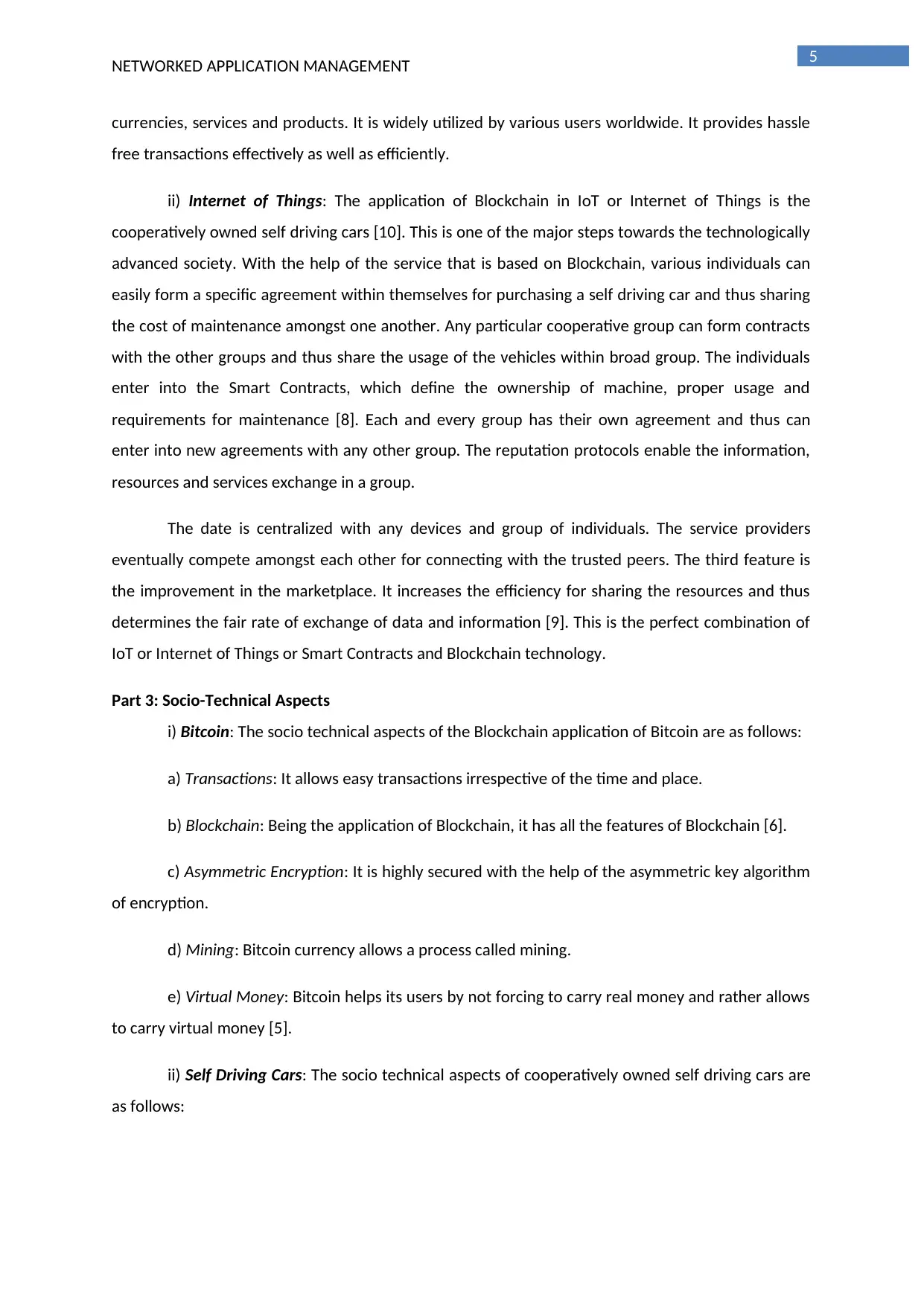
5
NETWORKED APPLICATION MANAGEMENT
currencies, services and products. It is widely utilized by various users worldwide. It provides hassle
free transactions effectively as well as efficiently.
ii) Internet of Things: The application of Blockchain in IoT or Internet of Things is the
cooperatively owned self driving cars [10]. This is one of the major steps towards the technologically
advanced society. With the help of the service that is based on Blockchain, various individuals can
easily form a specific agreement within themselves for purchasing a self driving car and thus sharing
the cost of maintenance amongst one another. Any particular cooperative group can form contracts
with the other groups and thus share the usage of the vehicles within broad group. The individuals
enter into the Smart Contracts, which define the ownership of machine, proper usage and
requirements for maintenance [8]. Each and every group has their own agreement and thus can
enter into new agreements with any other group. The reputation protocols enable the information,
resources and services exchange in a group.
The date is centralized with any devices and group of individuals. The service providers
eventually compete amongst each other for connecting with the trusted peers. The third feature is
the improvement in the marketplace. It increases the efficiency for sharing the resources and thus
determines the fair rate of exchange of data and information [9]. This is the perfect combination of
IoT or Internet of Things or Smart Contracts and Blockchain technology.
Part 3: Socio-Technical Aspects
i) Bitcoin: The socio technical aspects of the Blockchain application of Bitcoin are as follows:
a) Transactions: It allows easy transactions irrespective of the time and place.
b) Blockchain: Being the application of Blockchain, it has all the features of Blockchain [6].
c) Asymmetric Encryption: It is highly secured with the help of the asymmetric key algorithm
of encryption.
d) Mining: Bitcoin currency allows a process called mining.
e) Virtual Money: Bitcoin helps its users by not forcing to carry real money and rather allows
to carry virtual money [5].
ii) Self Driving Cars: The socio technical aspects of cooperatively owned self driving cars are
as follows:
NETWORKED APPLICATION MANAGEMENT
currencies, services and products. It is widely utilized by various users worldwide. It provides hassle
free transactions effectively as well as efficiently.
ii) Internet of Things: The application of Blockchain in IoT or Internet of Things is the
cooperatively owned self driving cars [10]. This is one of the major steps towards the technologically
advanced society. With the help of the service that is based on Blockchain, various individuals can
easily form a specific agreement within themselves for purchasing a self driving car and thus sharing
the cost of maintenance amongst one another. Any particular cooperative group can form contracts
with the other groups and thus share the usage of the vehicles within broad group. The individuals
enter into the Smart Contracts, which define the ownership of machine, proper usage and
requirements for maintenance [8]. Each and every group has their own agreement and thus can
enter into new agreements with any other group. The reputation protocols enable the information,
resources and services exchange in a group.
The date is centralized with any devices and group of individuals. The service providers
eventually compete amongst each other for connecting with the trusted peers. The third feature is
the improvement in the marketplace. It increases the efficiency for sharing the resources and thus
determines the fair rate of exchange of data and information [9]. This is the perfect combination of
IoT or Internet of Things or Smart Contracts and Blockchain technology.
Part 3: Socio-Technical Aspects
i) Bitcoin: The socio technical aspects of the Blockchain application of Bitcoin are as follows:
a) Transactions: It allows easy transactions irrespective of the time and place.
b) Blockchain: Being the application of Blockchain, it has all the features of Blockchain [6].
c) Asymmetric Encryption: It is highly secured with the help of the asymmetric key algorithm
of encryption.
d) Mining: Bitcoin currency allows a process called mining.
e) Virtual Money: Bitcoin helps its users by not forcing to carry real money and rather allows
to carry virtual money [5].
ii) Self Driving Cars: The socio technical aspects of cooperatively owned self driving cars are
as follows:
⊘ This is a preview!⊘
Do you want full access?
Subscribe today to unlock all pages.

Trusted by 1+ million students worldwide
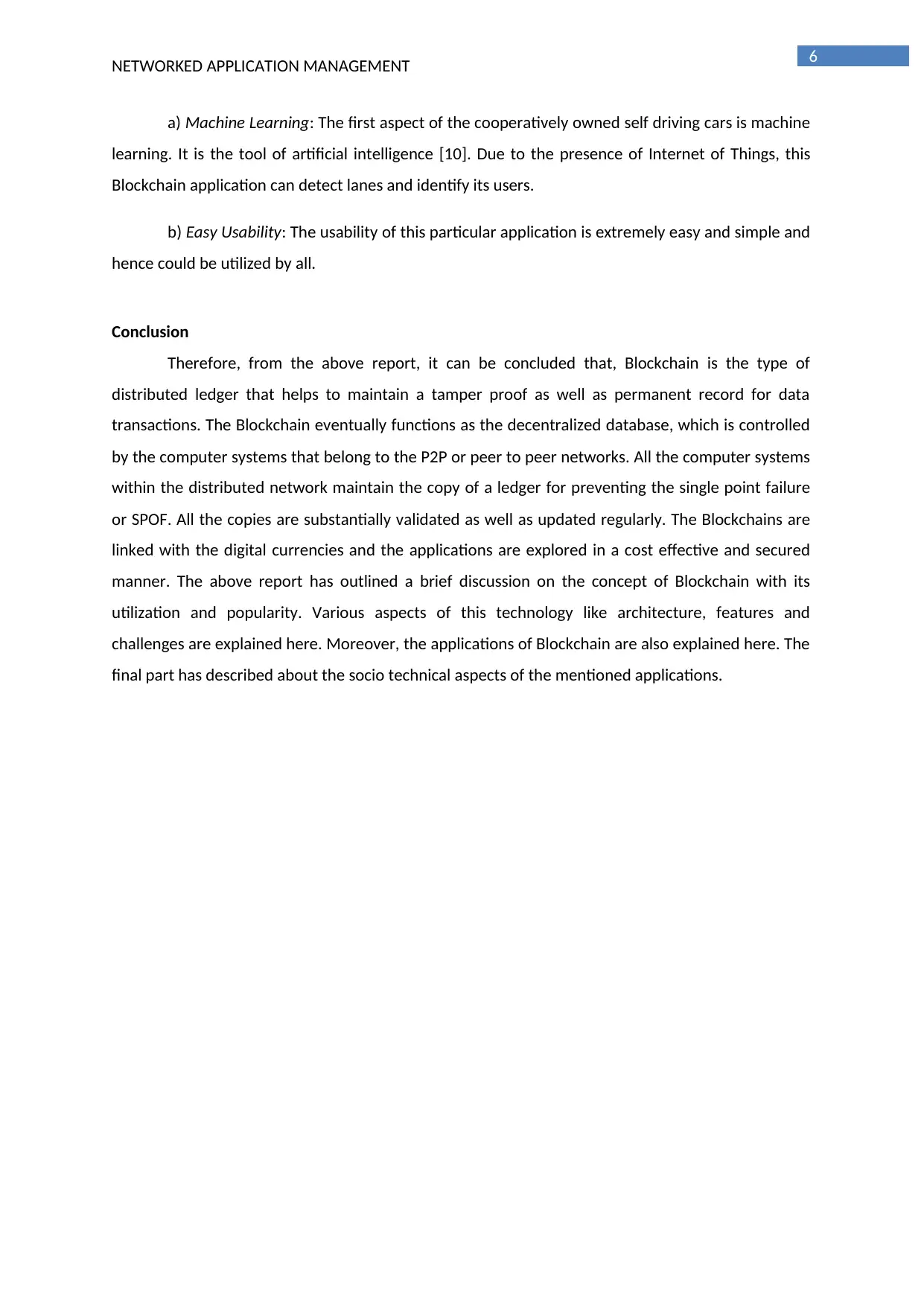
6
NETWORKED APPLICATION MANAGEMENT
a) Machine Learning: The first aspect of the cooperatively owned self driving cars is machine
learning. It is the tool of artificial intelligence [10]. Due to the presence of Internet of Things, this
Blockchain application can detect lanes and identify its users.
b) Easy Usability: The usability of this particular application is extremely easy and simple and
hence could be utilized by all.
Conclusion
Therefore, from the above report, it can be concluded that, Blockchain is the type of
distributed ledger that helps to maintain a tamper proof as well as permanent record for data
transactions. The Blockchain eventually functions as the decentralized database, which is controlled
by the computer systems that belong to the P2P or peer to peer networks. All the computer systems
within the distributed network maintain the copy of a ledger for preventing the single point failure
or SPOF. All the copies are substantially validated as well as updated regularly. The Blockchains are
linked with the digital currencies and the applications are explored in a cost effective and secured
manner. The above report has outlined a brief discussion on the concept of Blockchain with its
utilization and popularity. Various aspects of this technology like architecture, features and
challenges are explained here. Moreover, the applications of Blockchain are also explained here. The
final part has described about the socio technical aspects of the mentioned applications.
NETWORKED APPLICATION MANAGEMENT
a) Machine Learning: The first aspect of the cooperatively owned self driving cars is machine
learning. It is the tool of artificial intelligence [10]. Due to the presence of Internet of Things, this
Blockchain application can detect lanes and identify its users.
b) Easy Usability: The usability of this particular application is extremely easy and simple and
hence could be utilized by all.
Conclusion
Therefore, from the above report, it can be concluded that, Blockchain is the type of
distributed ledger that helps to maintain a tamper proof as well as permanent record for data
transactions. The Blockchain eventually functions as the decentralized database, which is controlled
by the computer systems that belong to the P2P or peer to peer networks. All the computer systems
within the distributed network maintain the copy of a ledger for preventing the single point failure
or SPOF. All the copies are substantially validated as well as updated regularly. The Blockchains are
linked with the digital currencies and the applications are explored in a cost effective and secured
manner. The above report has outlined a brief discussion on the concept of Blockchain with its
utilization and popularity. Various aspects of this technology like architecture, features and
challenges are explained here. Moreover, the applications of Blockchain are also explained here. The
final part has described about the socio technical aspects of the mentioned applications.
Paraphrase This Document
Need a fresh take? Get an instant paraphrase of this document with our AI Paraphraser
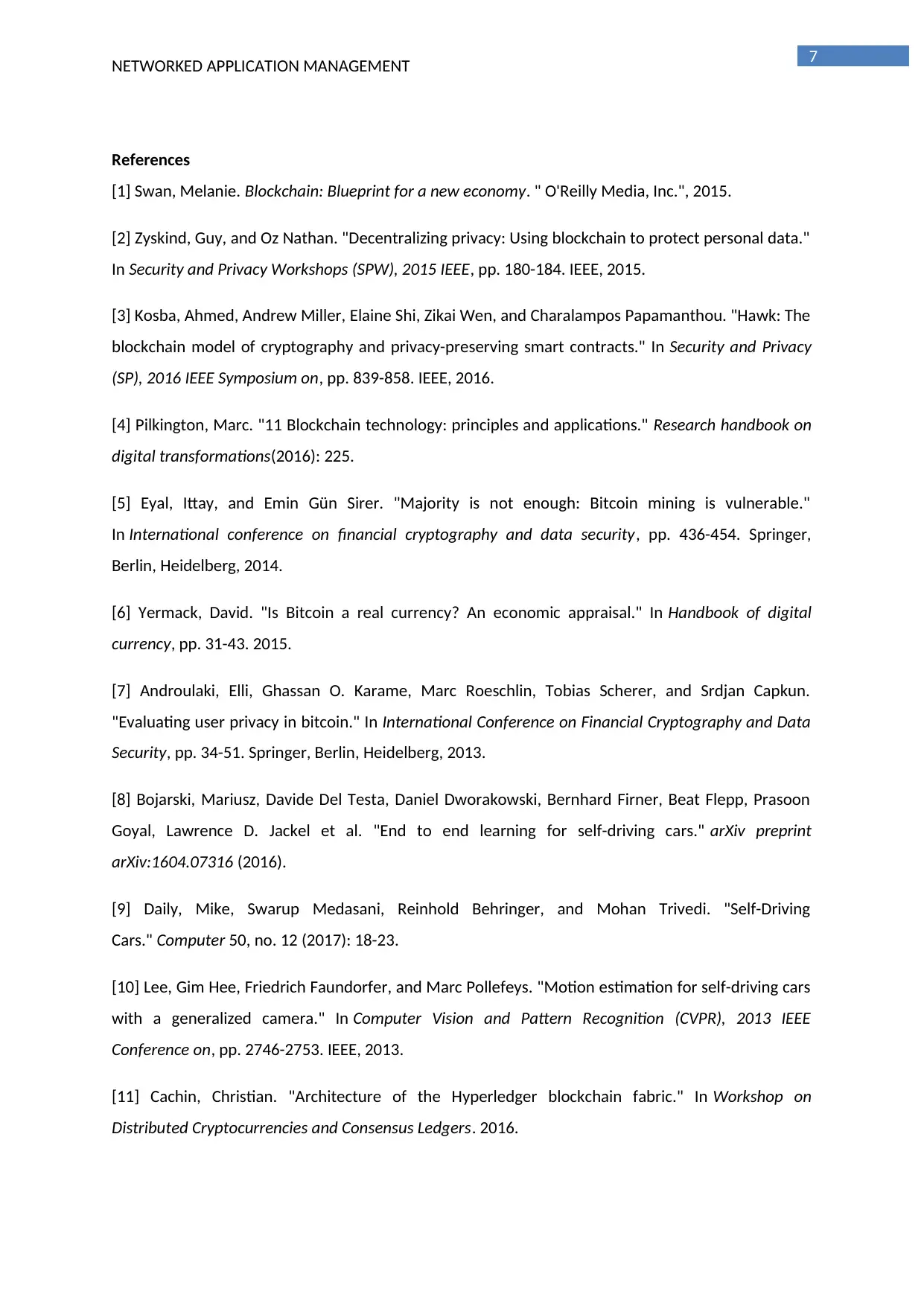
7
NETWORKED APPLICATION MANAGEMENT
References
[1] Swan, Melanie. Blockchain: Blueprint for a new economy. " O'Reilly Media, Inc.", 2015.
[2] Zyskind, Guy, and Oz Nathan. "Decentralizing privacy: Using blockchain to protect personal data."
In Security and Privacy Workshops (SPW), 2015 IEEE, pp. 180-184. IEEE, 2015.
[3] Kosba, Ahmed, Andrew Miller, Elaine Shi, Zikai Wen, and Charalampos Papamanthou. "Hawk: The
blockchain model of cryptography and privacy-preserving smart contracts." In Security and Privacy
(SP), 2016 IEEE Symposium on, pp. 839-858. IEEE, 2016.
[4] Pilkington, Marc. "11 Blockchain technology: principles and applications." Research handbook on
digital transformations(2016): 225.
[5] Eyal, Ittay, and Emin Gün Sirer. "Majority is not enough: Bitcoin mining is vulnerable."
In International conference on financial cryptography and data security, pp. 436-454. Springer,
Berlin, Heidelberg, 2014.
[6] Yermack, David. "Is Bitcoin a real currency? An economic appraisal." In Handbook of digital
currency, pp. 31-43. 2015.
[7] Androulaki, Elli, Ghassan O. Karame, Marc Roeschlin, Tobias Scherer, and Srdjan Capkun.
"Evaluating user privacy in bitcoin." In International Conference on Financial Cryptography and Data
Security, pp. 34-51. Springer, Berlin, Heidelberg, 2013.
[8] Bojarski, Mariusz, Davide Del Testa, Daniel Dworakowski, Bernhard Firner, Beat Flepp, Prasoon
Goyal, Lawrence D. Jackel et al. "End to end learning for self-driving cars." arXiv preprint
arXiv:1604.07316 (2016).
[9] Daily, Mike, Swarup Medasani, Reinhold Behringer, and Mohan Trivedi. "Self-Driving
Cars." Computer 50, no. 12 (2017): 18-23.
[10] Lee, Gim Hee, Friedrich Faundorfer, and Marc Pollefeys. "Motion estimation for self-driving cars
with a generalized camera." In Computer Vision and Pattern Recognition (CVPR), 2013 IEEE
Conference on, pp. 2746-2753. IEEE, 2013.
[11] Cachin, Christian. "Architecture of the Hyperledger blockchain fabric." In Workshop on
Distributed Cryptocurrencies and Consensus Ledgers. 2016.
NETWORKED APPLICATION MANAGEMENT
References
[1] Swan, Melanie. Blockchain: Blueprint for a new economy. " O'Reilly Media, Inc.", 2015.
[2] Zyskind, Guy, and Oz Nathan. "Decentralizing privacy: Using blockchain to protect personal data."
In Security and Privacy Workshops (SPW), 2015 IEEE, pp. 180-184. IEEE, 2015.
[3] Kosba, Ahmed, Andrew Miller, Elaine Shi, Zikai Wen, and Charalampos Papamanthou. "Hawk: The
blockchain model of cryptography and privacy-preserving smart contracts." In Security and Privacy
(SP), 2016 IEEE Symposium on, pp. 839-858. IEEE, 2016.
[4] Pilkington, Marc. "11 Blockchain technology: principles and applications." Research handbook on
digital transformations(2016): 225.
[5] Eyal, Ittay, and Emin Gün Sirer. "Majority is not enough: Bitcoin mining is vulnerable."
In International conference on financial cryptography and data security, pp. 436-454. Springer,
Berlin, Heidelberg, 2014.
[6] Yermack, David. "Is Bitcoin a real currency? An economic appraisal." In Handbook of digital
currency, pp. 31-43. 2015.
[7] Androulaki, Elli, Ghassan O. Karame, Marc Roeschlin, Tobias Scherer, and Srdjan Capkun.
"Evaluating user privacy in bitcoin." In International Conference on Financial Cryptography and Data
Security, pp. 34-51. Springer, Berlin, Heidelberg, 2013.
[8] Bojarski, Mariusz, Davide Del Testa, Daniel Dworakowski, Bernhard Firner, Beat Flepp, Prasoon
Goyal, Lawrence D. Jackel et al. "End to end learning for self-driving cars." arXiv preprint
arXiv:1604.07316 (2016).
[9] Daily, Mike, Swarup Medasani, Reinhold Behringer, and Mohan Trivedi. "Self-Driving
Cars." Computer 50, no. 12 (2017): 18-23.
[10] Lee, Gim Hee, Friedrich Faundorfer, and Marc Pollefeys. "Motion estimation for self-driving cars
with a generalized camera." In Computer Vision and Pattern Recognition (CVPR), 2013 IEEE
Conference on, pp. 2746-2753. IEEE, 2013.
[11] Cachin, Christian. "Architecture of the Hyperledger blockchain fabric." In Workshop on
Distributed Cryptocurrencies and Consensus Ledgers. 2016.
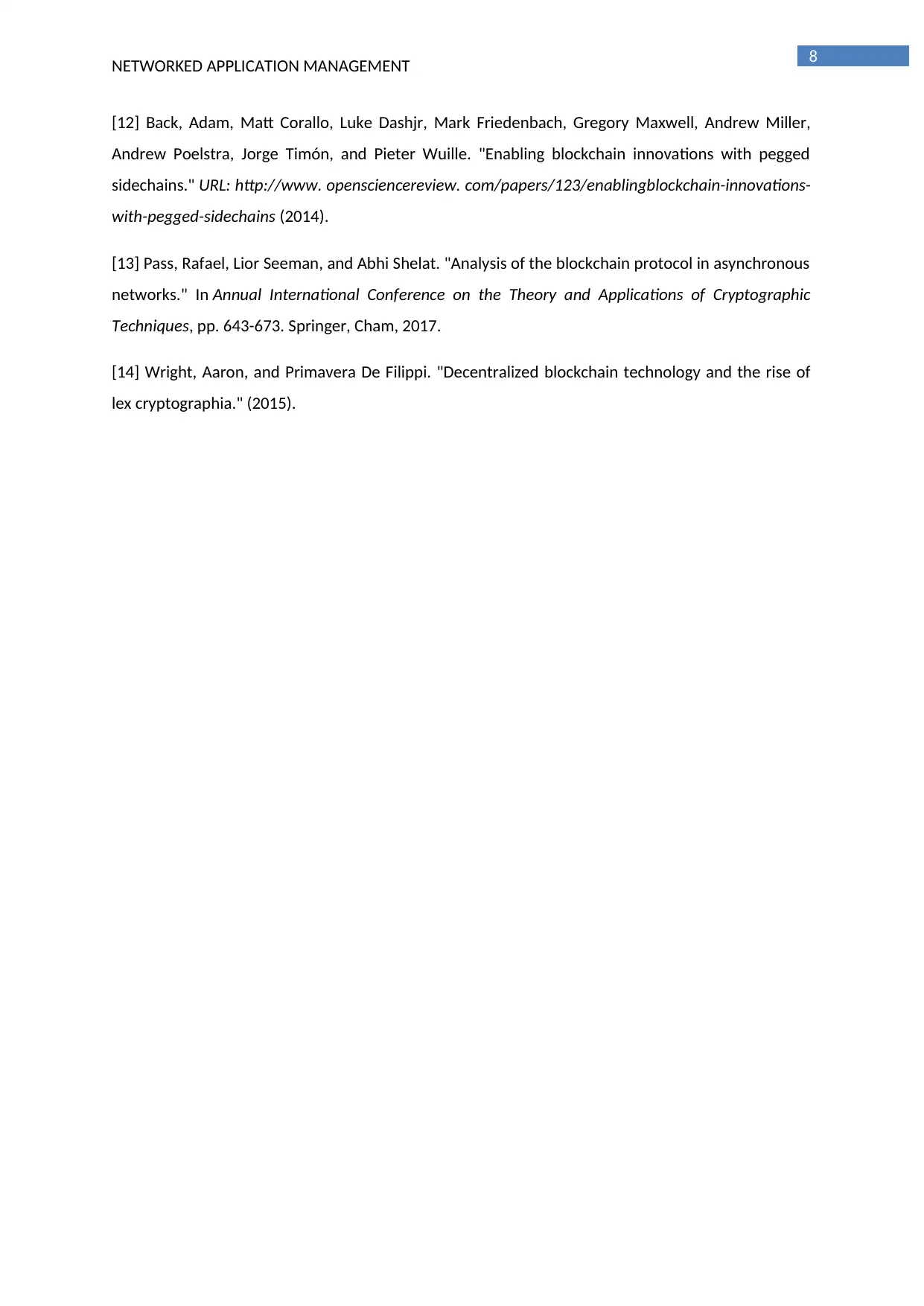
8
NETWORKED APPLICATION MANAGEMENT
[12] Back, Adam, Matt Corallo, Luke Dashjr, Mark Friedenbach, Gregory Maxwell, Andrew Miller,
Andrew Poelstra, Jorge Timón, and Pieter Wuille. "Enabling blockchain innovations with pegged
sidechains." URL: http://www. opensciencereview. com/papers/123/enablingblockchain-innovations-
with-pegged-sidechains (2014).
[13] Pass, Rafael, Lior Seeman, and Abhi Shelat. "Analysis of the blockchain protocol in asynchronous
networks." In Annual International Conference on the Theory and Applications of Cryptographic
Techniques, pp. 643-673. Springer, Cham, 2017.
[14] Wright, Aaron, and Primavera De Filippi. "Decentralized blockchain technology and the rise of
lex cryptographia." (2015).
NETWORKED APPLICATION MANAGEMENT
[12] Back, Adam, Matt Corallo, Luke Dashjr, Mark Friedenbach, Gregory Maxwell, Andrew Miller,
Andrew Poelstra, Jorge Timón, and Pieter Wuille. "Enabling blockchain innovations with pegged
sidechains." URL: http://www. opensciencereview. com/papers/123/enablingblockchain-innovations-
with-pegged-sidechains (2014).
[13] Pass, Rafael, Lior Seeman, and Abhi Shelat. "Analysis of the blockchain protocol in asynchronous
networks." In Annual International Conference on the Theory and Applications of Cryptographic
Techniques, pp. 643-673. Springer, Cham, 2017.
[14] Wright, Aaron, and Primavera De Filippi. "Decentralized blockchain technology and the rise of
lex cryptographia." (2015).
⊘ This is a preview!⊘
Do you want full access?
Subscribe today to unlock all pages.

Trusted by 1+ million students worldwide
1 out of 9
Related Documents
Your All-in-One AI-Powered Toolkit for Academic Success.
+13062052269
info@desklib.com
Available 24*7 on WhatsApp / Email
![[object Object]](/_next/static/media/star-bottom.7253800d.svg)
Unlock your academic potential
Copyright © 2020–2025 A2Z Services. All Rights Reserved. Developed and managed by ZUCOL.



